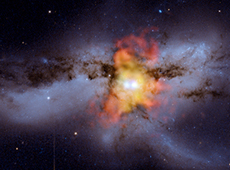Q. What kind of influence do you think the observation results from MAXI will have on future space research?

Two black holes at the center of galaxy NGC6240, about to crash into each other. A composite image using observation data from the Hubble Space Telescope and the Chandra X-ray Observatory. (Courtesy: X-ray (NASA/CXC/MIT/C. Canizares, M. Nowak); Optical (NASA/STScI))

Artist’s rendition of a gamma-ray burst (Courtesy: ESO/A. Roquette)
MAXI is more sensitive than previous all-sky X-ray observation payloads, so I think we have a better chance of obtaining interesting phenomena early and performing simultaneous observations at multi-wavelengths. In addition, since MAXI observes the sky continuously with a wider field of view, it can monitor about 500 or more astronomical objects at once. Long-duration observations with this improvement give us chances of encountering new aspects of variability of astronomical objects, and allow us to carry out our research systematically.
For example, long-term observation is a very effective way to study active galactic nuclei. Active galaxies are special galaxies with a huge massive black hole at the center, and they are still not well understood. Observing them over a long period, we may have a chance to detect periodic or quasi-periodic variability for the first time. In addition, we have already observed the coalescence of massive black holes, but if we could capture the signs of such an event prior to coalescence, that would be a great discovery. When celestial objects coalesce, X-rays are released, so if we keep observing the X-rays over time before the coalescence occurs, we might be able to detect a "gravitational wave" for the first time. I think it is very important to detect these moments of such variability. Q. What kind of research do you want to perform with MAXI in the future? I’d like to systematize the causes of intensive variabilities of celestial objects. Specifically, I’d like to conduct systematic observation of various jets generated in the Universe. For instance, we are observing an X-ray source in the constellation Circinus - an X-ray binary star system known as Circinus X-1 - in collaboration with radio-wave astronomy researchers. During our continuous observations with MAXI, we detected several small bursts - or flares - of X-rays. Our Dutch radio-wave collaborators pointed their instruments in the same direction, and detected a small jet of matter. In the past, without this kind of collaborative observation, these small jets were hard to detect. So this stimulated our confidence in our ability to detect smaller celestial phenomena such as these.
There is some variety of the jet scale. There are jets from enormous active galaxies, neutron stars, black holes, and solar flares. But these jets are sudden phenomena and we cannot predict where and when they will occur, so it is very hard to find them unless we are observing the entire sky. For this reason, these jets have rarely been observed with X-rays till now. Since MAXI detected the moment of jet generation through X-rays generated from Circinus X-1, worldwide expectations for MAXI have gone up.
As I explained, I’d like to collect a good deal of observation data on various sized jets, and my goal is to systematize this information.
* Please click here to learn more about the Monitor of All-sky X-ray Image (MAXI).
Special Advisor to the Space Observation Experiment MAXI Group at RIKEN Advanced Science Institute
Project co-researcher at the ISS Science Project Office, JAXA, Institute of Space and Astronautical Science (ISAS).
After working as an associate professor at the University of Tokyo and as an affiliate professor at ISAS, Dr. Matsuoka was appointed Principal Researcher at RIKEN and an invited senior researcher at JAXA. Since the start of X-ray astronomy research in 1962, he has made discoveries in a wide range of fields, such as X-ray bursts, active galaxies, and gamma-ray bursts. Additionally, one month after MAXI’s observations began, Dr. Matsuoka was invited to the 2009 X-Ray Astronomy Conference in Italy, and presented MAXI’s initial results internationally.
"I think living creatures are works of art."
Enhancing Quality of Life through Deep Understanding of Protein Structure
Space Medicine: Ultimate Preventive Medicine for Human Space Flight
The X-ray Observatory to Make the Violent Universe Visible

